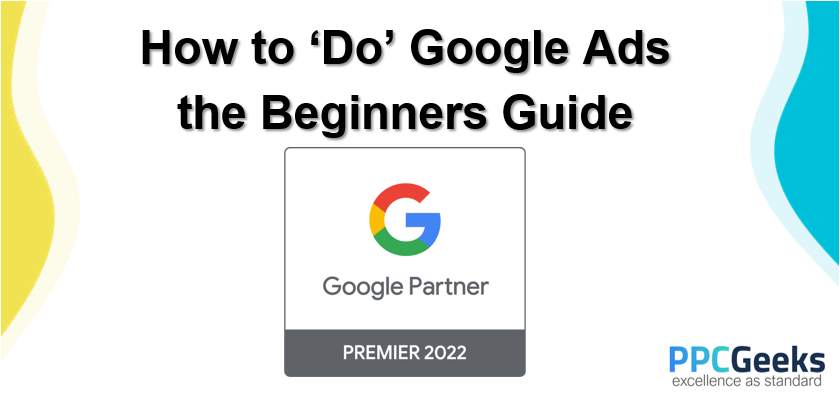How to Set Up and ‘Do’ Google Ads
If you’re a marketer who wants to start capitalizing on the meteoric number of searches that take place on Google every single day, and simultaneously generate the awareness you need to increase your ROI, then there’s no time like...

If you’re a marketer who wants to start capitalizing on the meteoric number of searches that take place on Google every single day, and simultaneously generate the awareness you need to increase your ROI, then there’s no time like the present to start harnessing the power of Google Ads.
There are so many marketing tools and methods out there, so it can sometimes be hard to determine which is a good fit for you and your business – but, with the help of an adept Google Ads specialist and an in-depth checklist, you can’t go wrong when using Google Ads.
Google Ads is Google’s online marketing platform which helps you create online ads to reach audiences that are interested in the products and services you provide. This platform runs on a Pay-Per-Click (PPC) model, meaning you have to pay every time a visitor clicks your ad.
So, whether you work for a Google Ads company or a PPC agency, here’s a simple guide on everything you need to know about how to ‘do’ Google Ads.
Google Ads How-to “Do” Steps
Learn a Number of Key Terms & Phrases
Whether you’re researching if Google Ads are right for your business, or preparing to set up your first campaign, it’s important to get to grips with some key terms and phrases. These include:
Keywords – Keywords are the words or phrases that people type into Google on a regular basis, which then trigger your ad to appear on their devices. When you or your trusted PPC management team set up any Google Ads campaign, you need to select a list of keywords that you think people might search for when they want to locate your product or service.Bid/ Bidding – A bid is not so much a monetary value, but rather the maximum amount you want to spend when someone clicks on your ad. It’s important to get this figure right, or at least as close to what you want to spend as possible.CPC (Cost-Per-Click) – Unlike a bid, CPC is the actual amount you pay when someone clicks on your ad. Your bid is simply a range within which your CPC may fall within.So, if you can get a good handle on some of these key terms and phrases, then your Google Ads can certainly succeed in Google’s competitive search engine marketplace.
Organize Your Account
How you organize your account could, in fact, define how you go on to succeed in the future. Start by breaking down your products or services into solidly defined categories that have strict limitations, and then base your account structure on those.
Google is split into two levels of organization: high-level campaigns and low-level campaigns:
High-level Campaigns – High-level campaigns should represent larger categories in your business. These ads should be your main products or services, or at least the largest components within your back catalog.Low-level Campaigns – Low-level campaigns, on the other hand, represent a smaller, more specific range of products or services. In essence, these ads should encompass the more unique products in your arsenal.Indeed, the more focussed, specific, and unique your ads are, the more people you can reach, whilst separating your products into high and low categories helps to spread your business more widely.
Pick & Match Your Keywords
Most Google Ads experts live and die by the keywords they choose to try and rank for. Moreover, you want your keywords to be as relevant as possible to your products, especially if you want them to trigger a reaction and lead a potential consumer to one of your landing pages.
A keyword planner can help you to generate a sample list of keywords for your campaigns, however, it’s hugely important to do your own research and target keywords that have low competition but an extremely high search volume.
In addition, Google Ads lets you further refine your keywords and what they show up for on Google through the help of ‘Broad match,’ which serves up your ads for a range of searches, be it someone who’s searched for your keywords but in a unique order, or for a related term that does not necessarily encompass your key phrase.
From negative match to exact match, choosing and matching your keywords, when done right, could help to catapult your ads to the next level.
Build & Optimise Your Landing Pages
Speaking of landing pages, it’s vital you build these with your Google Ads in mind. Your landing page is where potential customers land after clicking on your ad, so it’s important to make it relevant to your ad and keywords so to help users locate what they’re looking for more quickly.
One thing is for certain, usability should be at the forefront of every decision you make when building your landing page.
Choose Which Devices to Appear On
Having a complete understanding of who your ideal customer is is hugely important when choosing what devices you want your ads to appear on.
Maybe you work for a Google Shopping agency and are therefore more interested in reaching shoppers on their mobile devices, or maybe you’re dedicated to converting those who use a desktop computer 90% of the time.
Whatever it may be, it’s beneficial to have a close grip on who your ideal target market is before deciding which devices to appear on, and then, and only then, should you move to the next step of the process: writing your ads.
Write Your Ads
Think of your ad as your shopfront; your first impression, so make sure it reflects your business perfectly, communicating to the public that you have exactly what they’ve been looking for this entire time.
Don’t forget to include your keywords in your titles and ad copy, but also don’t forget to express your creativity and to get across exactly what makes your product or service so special.
In addition, include a CTA (call-to-action) in your ad. A CTA is a clear, concise, and potent message that tells the reader in 3-4 words what you’d like them to do.
Phrases like ‘click here,’ ‘sign up,’ or ‘click to subscribe,’ are great examples of how you can entice people to interact with your ad.

Hit GO and Analyze Your Results
Congratulations! If you’ve completed the above steps, then you should be ready to activate your campaign. But that was just the beginning. Now, it’s vital to check back in frequently with your campaigns and analyze what ads are generating the most clicks and conversions.
Over time, you should start to see a clear pattern emerge, and then you can apply this newfound knowledge to all of your campaigns moving forward.
PPC Geeks: Google Ads Specialists
And that’s it: that’s how you ‘do’ Google Ads. Whether you’re the most adept Google Ads consultant or you work for a leading PPC agency, it’s always useful to refresh your knowledge and make sure you understand why it’s important to set up and ‘do’ Google Ads in this way.
As an award-winning, Google Premier Partner, PPC Geeks pride themselves on how they keep you abreast of the latest updates from the marketing industry.
That said, if you require any help with this or want to improve your Google Ads campaigns in general, then why not invest in one of their 100% free PPC audits?

 Lynk
Lynk 








![How To Create An Infographic In Powerpoint [+Free Templates]](https://blog.hubspot.com/hs-fs/hub/53/file-2545046261-png/00-Blog-Related_Images/blog-freature-image-infographic-templates.png#keepProtocol)

![5 Best Answers to "Why Do You Want to Work Here?" [+ Why They Work]](https://blog.hubspot.com/hubfs/why-work-here-fi%20%281%29.jpg#keepProtocol)





















